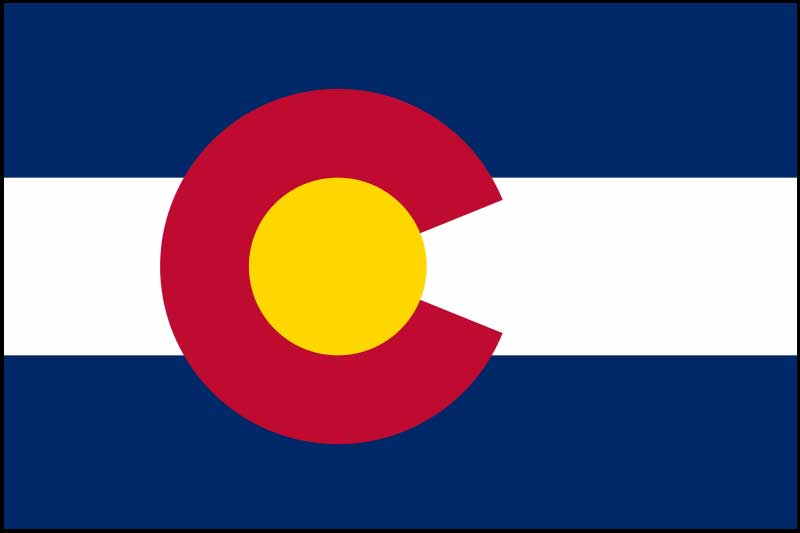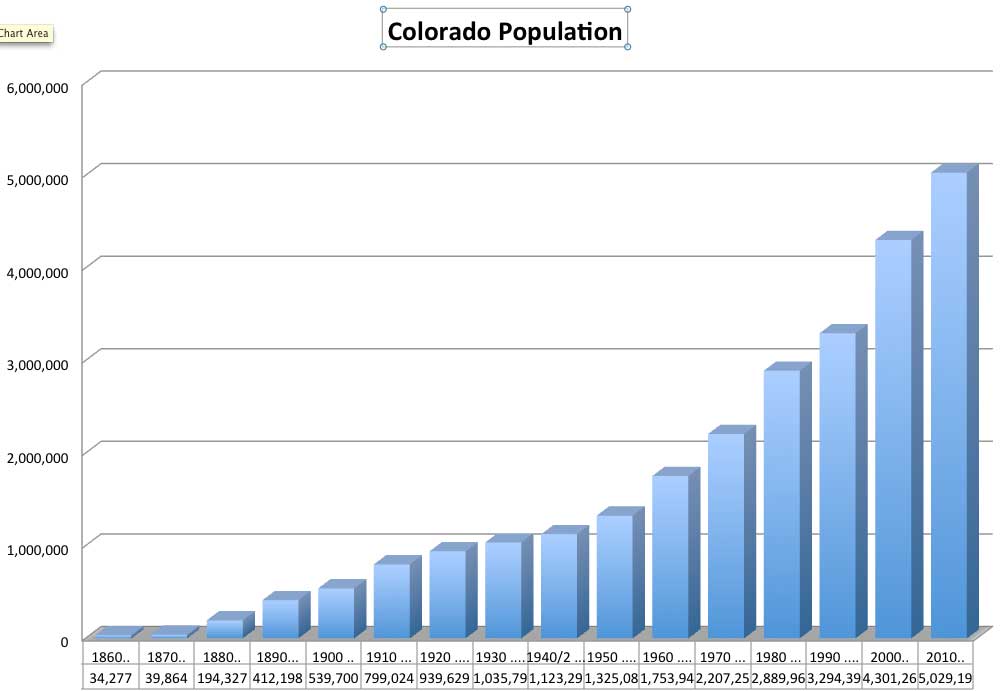Colorado


Basic Information
Postal Abbreviation: CO
Natives: Coloradan
Population 2020: 5,773,714
Legal Driving Age: 18
Age of Majority: 18
Median Age: 36.1
State Song:
“Where the Columbines Grow”
Lyrics & Music: A.J. Flynn
Median Household Income:$65,458
Capital..... Denver
Entered Union..... Aug. 1, 1876 (38th)
Present Constitution Adopted: 1876
Nickname: Centennial State
Motto:
“Nil Sine Numine” (Nothing without Providence)
Origin of Name:
From the Spanish for "red" or "ruddy"– describing the Colorado River.
USS Colorado
Railroad Stations
Colorado Economy
AGRICULTURE: cattle, chickens, corn,
flowers, hay, lamb, milk, sheep,
vegetables, wheat, wool.
MINING: coal, diamonds, gold, lead,
natural gas, petroleum, sand, silver,
stone, uranium, zinc
MANUFACTURING: Chemicals,
clothing, electronics, machinery,
printing, rubber products, scientific
instruments.

Colorado Geography
Total Area: 104,100 sq. miles
Land area: 103,730 sq. miles
Water Area: 371 sq. miles
Geographic Center: Park County
30 mi. NW of Pikes Peak
Highest Point: Mount Elbert
Lake County (14,433 ft.)
Lowest Point: Arkansas River, Prowers County
(3,350 ft.)
Highest Recorded Temp.: 118˚ F (7/11/1888)
Lowest Recorded Temp.: -61˚ F (2/1/1985)
Colorado is traversed by the Rock Mountains. There are over 800 peaks that are each more than 10,000 feet high. The eastern part of the state is part of The Great Plains. These plains slope upward slowly, until they reach the Rockies. A number of major rivers begin in Colorado: the North and South Platte, the Arkansas and the Rio Grande.
Cities
Denver, 716,492
Colorado Springs, 472,688;
Aurora, 374,114;
Fort Collins, 167,830;
Lakewood, 167,830s;
Thornton, 139,436;
Westminster, 113,479;
Arvada, 120,492
Pueblo, 111,750;
Centennial, 110,831
Castle Rock, 81,485
Colorado History
1700 The first French explorers reached the Rocky mountains.
1779 During the 1700’s various groups of Spanish and French explorers.
1806 Lieutenant Zebulon Pike leads a group of 15 soldiers in an attempt to scale
Pike's Peak.
1819 Under the terms of the Adams-Onis treaty Eastern Colorado became
American territory while the remainder was Spanish.
1835 Bents fort was completed near La Junta, it served as a rendezvous point for
trappers and traders.
1842-53 John Fremont led five expeditions through Colorado while exploring
the west.
1848 Under the terms of the treaty of Guadalup Hidalgo Colorado was ceded to
the United States.
1858 Gold was found along the Cherry Creek where Denver is now located.
1870 Denver becomes linked to the national rail network.
1876 Colorado was admitted to the Union as the 38th state.
1880 was the peak of the silver boom which centered at Leadville whose
population swells to 25,000 and whose town includes an opera house.
1915 The Rocky Mountain National was created.
1957 NORAD is established in Colorado Springs, the next year the Air Force
academy is created there.
Famous People
Scott Carpenter
Jack Dempsey
Mamie Eisenhower
Douglas Fairbanks
Lowell Thomas
Byron R. White

Colorado National Sites
1) Bent’s Fort
This fort was an important trading post along the Sante Fe Trail
2) Black Canyon of the Gunnison National Monument
This monument covers 12 miles of the Gunnison River that is by sheer canyon. The monument covers 20,700 acres.
3) Colorado National Monument
The monument is located in the western part of state. It cover 20,450 acres of canyon land.
4) Dinosaur National Park
In this park which covers 211,000 acres the remains of dinosaurs were found in sandstone quarries.
5) Florissant Fossil Beds National Monument
This area is known for its rich source of insect fossils.
6) Great Sand Dune National Monument
This 155 square mile park at the base of the Sangre De Cristo Mountains is covered with sand and sand dunes
7) Hovenweep National Monument
This site contains the remains of the dwelling of pre Historic Pueblo Indians. As well as cliff houses of later Indian dwellers.
8) Mesa Verda National Park
This park contains the remains of series of Indians that abandoned their homes in the 13th century. It covers 52,074 acres.
9) Rocky Mountain National Park
This National Park straddles the Continental divide north of Denver. It contains 78 peaks higher then 12,000 feet. Its area is over 265,727 acres.
 >
>